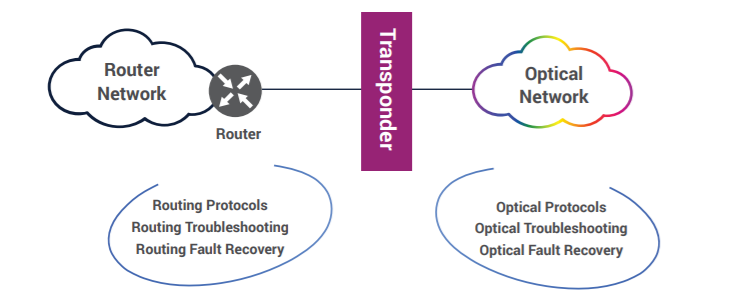A DWDM Guide: Definition, Benefits, and When You Should Use It
Today’s telecom, cable, and data providers constantly compete to provide the best, most reliable service to customers, while investing in the right technologies to maintain the integrity of data and enable the separation of users. Because of this, service providers often spend countless hours searching for cost-effective, yet future-proof solutions that fit their business needs.
This is where DWDM comes in. Dell'Oro forecasts the total DWDM market to grow at a 3% compound annual growth rate (CAGR) to $18 billion by 2026. This is a direct result of the sale of DWDM systems.
In this guide we’ll explore DWDM systems, including the components, benefits, how they work and compare to other systems, and as a result, you’ll have the information you need to make the right choice for your business.
What is DWDM?
Dense wavelength-division multiplexing (DWDM) is an optical transmission technology that uses multiple wavelengths of light to combine several data streams onto a single optical fiber. DWDM is a variant of Wavelength-Division Multiplexing (WDM). DWDM leverages tighter wavelength spacing to accommodate more channels, as opposed to other WDM technologies. The high number of channels available to DWDM enables the technology to transmit large amounts of data on a single cable. Want to better understand optical networking?
Check out this blog about what OTN can do for you.
What is WDM?
Wavelength-Division Multiplexing (WDM) converts several different data streams into wavelengths of light using a multiplexer that combines those streams before transmitting them over a fiber optic cable. This cable is then de-multiplexed at the receiving end and split back into its respective streams of data. WDM makes up the backbone of most carrier systems because it allows them to use a single line of fiber optic cable to provide high speed services, without sacrificing quality and reducing latency.
How does DWDM work?
As a dense form of WDM, DWDM uses the same kind of multiplexer during the transmission method, except it fits more channels on its cable. Let’s take a closer look at the entire DWDM process to get a deeper understanding of how DWDM works:
- The data stream enters through the router and is sent into the transponder, which has a single client port and a single wavelength port.
- The transponder maps the signal to a DWDM wavelength. This wavelength is now ready to join other wavelengths on the fiber optical line.
- The DWDM signal is sent to optical add/drop multiplexers (OADM) that combines and uncombines multiple signals coming from the transponders onto the fiber.
- The combined optical signal leaves the OADM and travels through the fiber optic network.
- Amplifiers boost the signal approximately every 60 miles.
- The signal arrives at its destination and gets de-multiplexed into individual DWDM wavelengths.
- The DWDM waves pass through the receiving transponder and are converted into data.
- The data stream is now routed to its final destination.
- Besides transponders, there are also muxponders that operate in the same fashion but have multiple client ports with a single wavelength port, and combine multiple data streams onto a single wavelength.
DWDM equipment can simultaneously transmit several types of data across an optical channel, including data, video, voice transmission, and more.

Metro DWDM vs Long Haul DWDM
Metro DWDM systems are used for transmitting data across moderate distances of a few hundred miles to cover a large metropolitan area. Whereas, long haul DWDM sends data across greater distances, often spanning hundreds or even thousands of miles. However, as providers strive to become more and more competitive (both locally and globally), many are beginning to implement both metro and long haul DWDM using both capacity-reach and power-cost optimized optical transport.
Learn how recent DWDM breakthroughs yield products that handle today’s requirements and help support future services.
What is the difference between CWDM vs DWDM?
There are two subsets of WDM: coarse WDM (CWDM) and dense WDM (DWDM)—both can transmit data of any mix over a single fiber on various channels. However, there is one major feature that separates the two. The wavelengths of DWDM systems are closer together than that of CWDM systems, which allows for more channel capacity. This nuance serves as the main differentiator because CWDM has limited channels, while DWDM not only supports more channels, but can be boosted to transmit data over farther distances. A typical DWDM system today can support up to 96 channels on a fiber pair with each channel carrying a 100 Gbps wavelength. Newer technologies are making available even faster speeds of 400 Gbps and even 800 Gbps per wavelength, this is over fewer but wider channels.
Now that we know what differentiates DWDM from other forms of WDM, let’s take a closer look at its components.
DWDM Components
Several components work together to make up a DWDM optical system. Below is a high-level overview of each component and its function:
- Router – sends the original data stream to the transponder.
- Transponder – maps the data stream to an outgoing light wavelength that suits the DWDM application.
- Muxponder – maps several data streams to an outgoing light wavelength that suits the DWDM application.
- Optical add/drop multiplexers (OADM) – consolidates multiple wavelengths of light onto an optical fiber
- Optical amplifiers – boosts the signal through the fiber optic network.
- Fiber optic cables – data travels across the fiber optic network as wavelengths of light.
- Receiving equipment – the signal arrives at its destination, goes through another OADM to de-multiplex it into different wavelengths, and moves through the transponder (or muxponder) and router to the receiving equipment (e.g. a television, computer, etc.)
Learn how optical networking delivers bandwidth scalability, resiliency, and manageability.
What are the Benefits of DWDM?
Data centers, telecom, and cable providers are constantly on the hunt for technologies that provide a strong ROI, while also meeting customers’ needs. This is an area where DWDM systems shine. Let’s take a closer look at some of the other benefits of the system:
- Transmits large amounts of data over long distances – this makes it suitable for long-haul transmission.
- Can be used with existing fiber optic cables – as optical technology continues to improve, providers can increase their data capacity on existing cables.
- Acts as a cost-effective solution – DWDM lowers cost because it eliminates the need for providers to lay down hundreds or thousands of kilometers of new fiber.
- Is protocol and bitrate independent – DWDM is capable of carrying various types of data across a single fiber optic cable, without interference, including voice, video, and text. This feature is beneficial to service providers who offer multiple services to their customers.
A Future-Proof DWDM Solution with Ribbon
As service providers continue to upgrade their technologies to provide reliable service to customers who utilize a mix of data, it becomes crucial to find a solution that maintains the integrity of data and enables the optimal separation of users.
Ribbon’s Optical Networking solution, Apollo Optical Networking System, helps carriers with a future-proof solution that suits their unique business needs. Ribbon customizes their optical networking solutions to each individual service provider, with multiservice transport, performance, or cost-power optimized transmission, optical encryption, DWDM, CDC-F ROADMs, access-to-core OTN switching, dynamic restoration, and integrated performance monitoring; all under SDN control.
Are you looking for the right technology for your organization and customers? Watch our webinar to learn which option may be the best fit for you.
Additional Resources
Webinar: Optical Networking/DWDM Demystified
Glossary: What is DWDM?
Blog: Are We Finally Entering the IP-over-DWDM Era?


